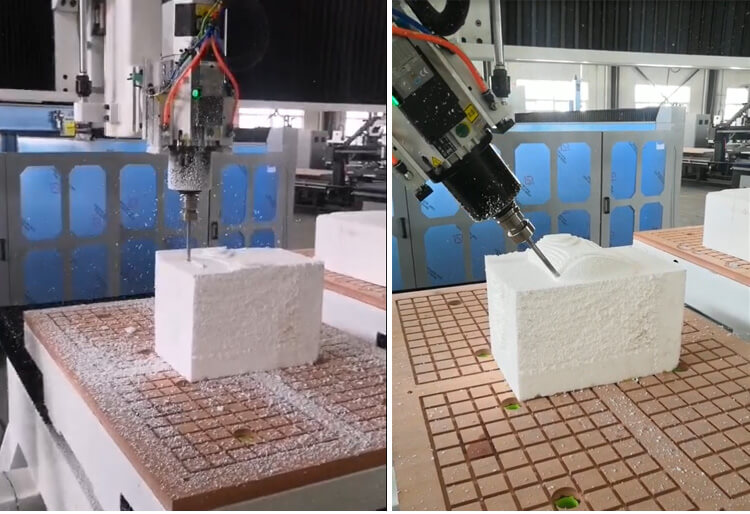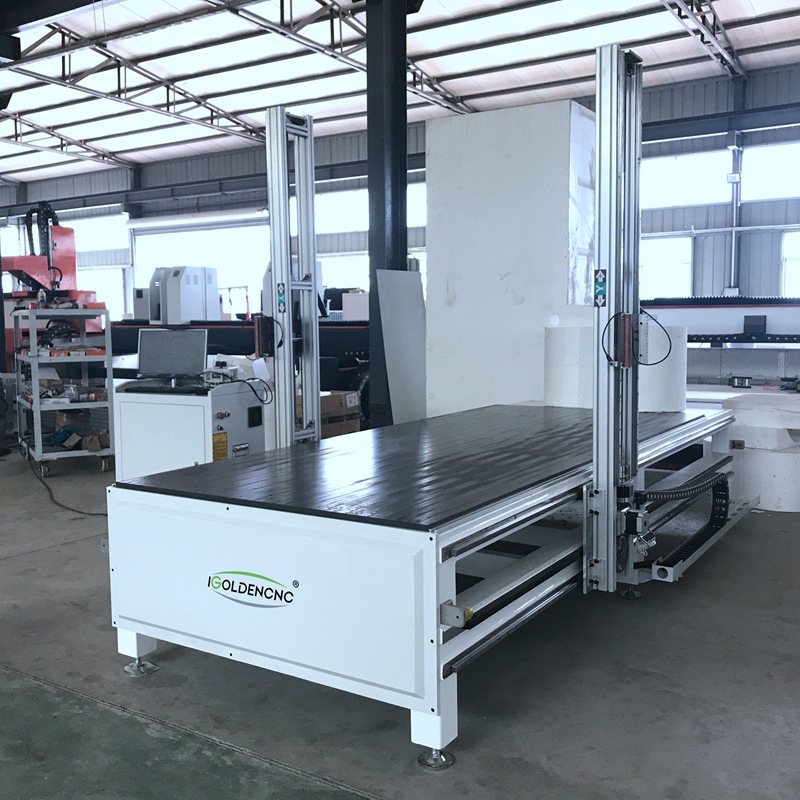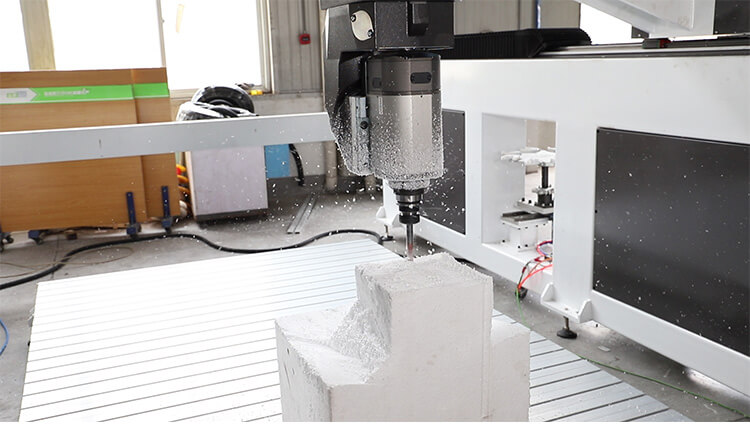3D CNC Foam Router 4 Axis 5 Axis
CNC foam router machine sophisticated piece of equipment is revolutionizing the way industries approach foam cutting, offering unparalleled precision, efficiency, and versatility. This article delves into the intricacies of 3D CNC foam router machines, exploring their applications, benefits, and the technological advancements that make them indispensable in today’s industrial and creative sectors.
CNC Foam Router
3D CNC foam router machine is a specialized tool designed to cut and shape foam materials with high precision. Utilizing computer programming, these machines can execute complex designs and patterns, making them ideal for a wide range of applications. The primary components of a 3D CNC foam router machine include the computer, the router, and the control unit, which work in unison to perform intricate operations.

CNC foam router machine is a specialized type of CNC machine designed for cutting, shaping, and carving foam materials. These machines are widely used in industries such as packaging, prototyping, model making, and even in the production of theater and movie props.

3D foam router machines often have a large cutting area to accommodate foam sheets or blocks of various sizes. This allows for the production of large-scale foam components or multiple smaller pieces in a single operation.
Types of CNC Foam Cutter
Hot Wire CNC Foam Cutter
Use a heated wire to cut through foam. Ideal for cutting polystyrene foams (EPS, XPS). Best for straight cuts, contours, and simple 3D shapes.

CNC foam cutter
Use a rotary cutting tool (router bit) to carve and shape foam. Suitable for detailed 3D carving, engraving, and milling. Can handle a wider range of foam types, including polyurethane and polyethylene.A CNC foam cutter is a specialized type of CNC machine designed to cut and shape foam materials with high precision and efficiency. These machines are commonly used in various industries, including packaging, prototyping, model making, insulation, and more.
Types of Foam Used
There are several types of foam that can be processed using a 3D CNC foam router machine:
- Polystyrene Foam (EPS): Commonly used for packaging and insulation.
- Polyurethane Foam (PU): Used in furniture, automotive, and aerospace industries.
- Polyethylene Foam (PE): Known for its durability and shock absorption properties.
- PVC Foam: Used in signage and display applications.
4 Axis Foam CNC Router
The 4-axis CNC Router machine refers to the computer numerical control equipment including X, Y, Z, and additional rotation axis. It has 3 straight coordinates and 1 rotating coordinate. 4-axis CNC Router engraving machines are usually equipped with rotating axes or rocking spindles, so they can contact the workpiece from different angles and effectively work, so as to realize the 3D processing of cylindrical, curved and circular surfaces.

4 axis CNC router is quite good at processing 3D workpieces. It generally falls into two types. The first type described hereunder is equipped with a rotating spindle that can swing by 180°. It can engrave 3D patterns and drill holes on side surfaces of wood, MDF, acrylic, foam, rubber, and other materials. For example, 3D letters, signs, reliefs, and sculptures.

5 Axis CNC Foam Router
The 5 axis CNC Router machine, also known as the 5 axis CNC machining center, is equipped with a 3D CNC system. It is designed as a 5 axis CNC processing solution with high cost-effectiveness. It refers to the ability of the machine to move tools or parts on five different axes to achieve complex surface processing.

As advanced CNC equipment, 5 axis CNC machining center or CNC router is designed specifically for complex curved surfaces. It is widely used in aviation, aerospace, automotive, military, scientific research, precision instruments, high-precision medical equipment, and other industries. It can process an extensive range of materials, such as wood, metals, stones, plastic, styrofoam, composites, etc.

Key Features of Foam Router Machine
- High-speed spindle and powerful motors to efficiently cut through foam materials.
- Precision control over the 3D toolpath to create complex geometries and intricate details.
- Ability to handle a variety of foam types, from soft expanded polystyrene (EPS) to high-density polyurethane (PU) foams.
- Integrated CAD/CAM software and advanced CNC control systems for streamlined design-to-production workflows.
- Large work envelopes and multiple-axis capabilities to accommodate large or complex foam parts.
- Dust extraction systems to maintain a clean work environment during the foam cutting process.
Applications of 3D CNC Foam Router Machines
In industries such as automotive, aerospace, and consumer goods, prototyping is a crucial phase of product development. 3D CNC foam router machines enable the creation of highly detailed and accurate prototypes, allowing for thorough testing and validation before mass production.

Prototyping and Model Making
In industries such as automotive, aerospace, and consumer goods, prototyping is a crucial phase of product development. 3D CNC foam router machines enable the creation of highly detailed and accurate prototypes, allowing for thorough testing and validation before mass production.
Signage and Displays
The advertising and retail sectors benefit greatly from the precision and versatility of 3D CNC foam router machines. These machines can create intricate signage, displays, and promotional materials that stand out and attract attention.
Packaging
Custom foam packaging solutions are essential for protecting delicate and high-value items during transportation. 3D CNC foam router machines can produce tailored packaging inserts that provide optimal protection and fit.
Artistic and Creative Projects
Artists and designers use 3D CNC foam router machines to bring their creative visions to life. From sculptures to stage props, these machines offer the precision and flexibility needed to execute complex designs.

Architectural and Design:
Creating complex 3D shapes, forms, and models for architectural visualizations and prototypes.
Fabricating decorative elements, sculptures, and large-scale installations using foam.

Automotive and Aerospace:
Producing custom molds, plugs, and patterns for composite part manufacturing.
Shaping foam components for vehicle interiors, such as seat cushions and headliners.


Benefits of Using 3D CNC Foam Router Machines
Precision and Accuracy
One of the most significant advantages of 3D CNC foam router machines is their ability to produce parts with exceptional precision. This level of accuracy is crucial in industries where even the smallest deviation can lead to significant issues.
Efficiency and Productivity
3D CNC foam router machines can operate continuously, 24/7, without fatigue. This capability significantly boosts productivity and reduces lead times, making them invaluable in high-demand manufacturing environments.
Versatility
These machines are incredibly versatile, capable of working with a wide range of foam materials. This versatility makes them suitable for various industries and applications.
Cost-Effectiveness
While the initial investment in a 3D CNC foam router machine can be substantial, the long-term benefits, including reduced labor costs and increased efficiency, often outweigh the initial expense.

Technological Advancements in 3D CNC Foam Router Machines
Integration with CAD/CAM Software
Modern 3D CNC foam router machines are often integrated with CAD (Computer-Aided Design) and CAM (Computer-Aided Manufacturing) software. This integration allows for seamless design and manufacturing processes, reducing errors and improving overall efficiency.
Automation and Robotics
The incorporation of automation and robotics into CNC machining has further enhanced productivity. Automated 3D CNC foam router machines can perform multiple tasks without human intervention, increasing throughput and reducing the risk of human error.
IoT and Industry 4.0
The advent of the Internet of Things (IoT) and Industry 4.0 has brought about significant changes in CNC machining. Machines are now connected to networks, allowing for real-time monitoring, predictive maintenance, and improved decision-making processes.

评论
发表评论